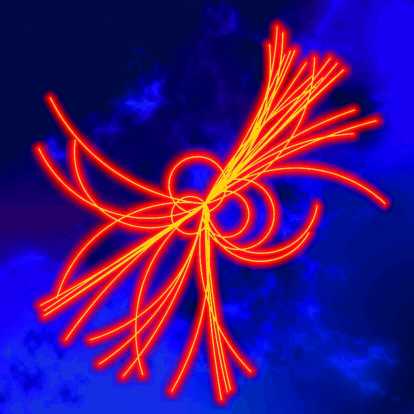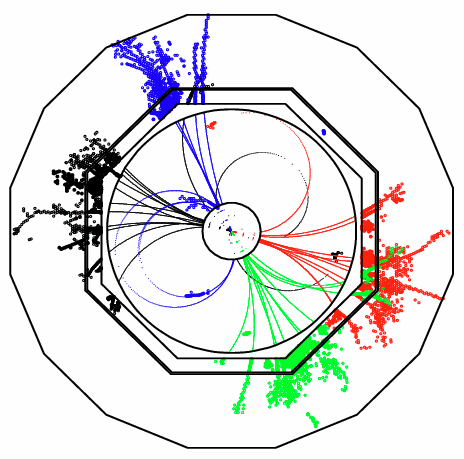

Detector & Physics in Zeuthen for a Linear Collider
Electroweak studies

High precision studies of electroweak processes offer a window to physics at higher energy scales than the one available at the ILC. The sensitivity to the new physics comes either via higher order loop corrections that are usually suppressed by the coupling constant or the new processes contribute directly to the process under study, but because of the high mass of the new particles they are suppressed by s/M2, where s is the squared centre of mass energy and M the mass of the new particles.
Mainly three types of processes were studied in this context:
- W-pair production in electron-positron and photon-photon collisions
- Z-boson production (Giga-Z)
- Extended gauge sector (heavy Z or extra dimensions)
To all three points significant contributions to the TESLA TDR and ILC RDR have been produced in Zeuthen. Special emphazis was put to studies which exploit the posibility of polarized beams.
Studies of W-pair production in electron-positron and photon-photon collisions
In case that no light Higgs exists electroweak interactions amongst gauge bosons become strong at the TeV scale, eventually violating unitarity. In this case deviations from the Standard Model predictions in W-pair productions should be visible at ILC. In the figure above a simulated e+e-→ννWW→ννqqqq event in the ILD is shown.
Studies of the properties of the Z-boson, running close to the peak of the Z-resonance (Giga-Z).
The usefulness of these studies has already been proven at LEP and SLD. From measurements of the decay rates of the Z and the effective weak mixing angle already in 1993 the mass of the top quark could be predicted with high accuracy, prior to its discovery at the TEVATRON. At present these data make us believe that the Higgs boson is light and in the reach of ILC. ILC offers the possibility to increase the LEP statistics by two orders of magnitude with polarised electron and positron beams. With this data sample the weak mixing angle could be measured a factor 10 better than now. Depending on the scenario of electroweak symmetry breaking, realised in nature, with this precision parameters of supersymmetric theories can be constrained or a non-standard Higgs sector can be tested.
Precision measurement of fermion pair production at high energies.
Away from the Z-resonance interactions mediated by new heavy particles are suppressed by a factor s/M2. Effects of these particles may be seen if the precision of the cross sections and distributions of fermion pairs is high enough. Possible effects of additional heavy Z-bosons or different types of models containing extra space dimensions have been studied. In all cases ILC is sensitive to mass scales of several TeV, often higher than the LHC, presently being built at CERN. However, since the LHC measures masses of the new particles directly while ILC measures the couplings of the new particles to fermion divided by the mass of the new particles only the combination of ILC and LHC can establish the model of new physics once deviations from the Standard Model predictions are found.
References
-
G. Moortgat-Pick et al., [POWER Collaboration],
Polarized positrons and electrons at the linear collider
Physics Reports 460 (2008) 131. -
A. Bartl, W. Majerotto, K. Mönig, A. N. Skachkova and N. B. Skachkov,
Pair production of scalar top quarks in e+ e- collisions at ILC,
arXiv:0804.2125 [hep-ph]. -
A. Bartl, W. Majerotto, K. Mönig, A. N. Skachkova and N. B. Skachkov,
Pair production of scalar top quarks in polarized photon-photon collisions at ILC,
arXiv:0804.1700 [hep-ph] -
K. Mönig,
Physics issues on triggering,
Procedings to the International Linear Collider Workshop (LCWS06) 9-13 Mar 2006, Bangalore, India,
Pramana 69 (2007) 1207-1208. -
K. Mönig,
Detector issues for a photon collider,
Procedings to the International Linear Collider Workshop (LCWS06) 9-13 Mar 2006, Bangalore, India,
Pramana 69 (2007) 1181-1184. -
E. Accomando et al.,
Report of the workshop on CP Studies and Non-Standard Higgs Physics,
arXiv:hep-ph/0608079. -
K. Mönig,
Physics of electroweak gauge bosons,
In *Fujii, K. (ed.) et al.: Linear collider physics in the new Millennium* 291-329 -
M. Beyer, W. Kilian, P. Krstonosic, K. Mönig, J. Reuter, E. Schmidt and H. Schröder,
Determination of new electroweak parameters at the ILC: Sensitivity to new physics,
Eur. Phys. J. C 48 (2006) 353 [arXiv:hep-ph/0604048]. -
G. Weiglein et al., [LHC/LC Study Group],
Physics interplay of the LHC and the ILC,
Phys. Rept. 426 (2006) 47 [arXiv:hep-ph/0410364]. -
G. Kribs, N. Okada, M. Perelstein and S. Riemann,
Beyond the Standard Model: Summary,
In the Proceedings of the 2005 International Linear Collider Physics and Detector Workshop and 2nd ILC Accelerator Workshop, Snowmass, Colorado, 14-27 Aug 2005.
eConf C0508141 (2005) ALCPG0101. -
S. Riemann,
Z' signals from Kaluza-Klein dark matter,
In the Proceedings of 2005 International Linear Collider Workshop (LCWS 2005), Stanford, California, 18-22 Mar 2005, pp 0303
eConf C050318 (2005) 0303 [arXiv:hep-ph/0508136]. -
K. Mönig,
Physics at future linear colliders,
Int. J. Mod. Phys. A 21 (2006) 1974 [arXiv:hep-ph/0509159]. -
P. Krstonosic, K. Mönig, M. Beyer, E. Schmidt and H. Schröder,
Experimental studies of strong electroweak symmetry breaking in gauge boson scattering and three gauge boson production,
In the Proceedings of 2005 International Linear Collider Workshop (LCWS 2005), Stanford, California, 18-22 Mar 2005, pp 0310,
arXiv:hep-ph/0508179. -
K. Mönig and A. Rosca,
Two-photon width of the Higgs boson,
In the Proceedings of 2005 International Linear Collider Workshop (LCWS 2005), Stanford, California, 18-22 Mar 2005, pp 0113
arXiv:hep-ph/0506271. -
I. Alvarez Illan and K. Mönig,
Selectron production in e gamma collisions at a linear collider,
LC-PHSM-2005-002 -
K. Mönig and J. Sekaric,
Measurement of triple gauge boson couplings at an e gamma collider,
Eur. Phys. J. C 38 (2005) 427 [arXiv:hep-ex/0410011]. -
K. Mönig and J. Sekaric,
Charged current triple gauge couplings at an e gamma collider,
In Proceedings to the International Conference on Linear Colliders (LCWS 04), Paris, France, 19-24 Apr 2004, vol. 1* 273-277. -
S. Riemann,
Aspects of new gauge bosons searches at LHC/LC,
In Proceedings to the International Conference on Linear Colliders (LCWS 04), Paris, France, 19-24 Apr 2004, vol. 1* 237-241. -
K. Mönig, J.Sekaric,
A Study of Charged Current Triple Gauge Couplings at an e-gamma collider
LC-PHSM-2003-072 -
V. Makarenko, K. Mönig and T. Shishkina,
Measuring the luminosity of a gamma-gamma collider with gamma,gamma -> lepton,lepton,gamma events
Eur. Phys. J. C 32S1 (2003) 143 [arXiv:hep-ph/0306135]. -
K. Mönig,
Electroweak Gauge Bosons and Alternative Theories
Proceedings of the ECFA/DESY workshop on linear colliders, Amsterdam, April 2003,
arXiv:hep-ph/0309021. -
K. Mönig,
Physics of Electroweak Gauge Bosons
in "Linear Collider Physics in the New Millennium", edited by K. Fujii, D. Miller and A. Soni, World Scientific,
arXiv:hep-ph/0303023 -
I. Bozovic-Jelisavcic, K. Mönig, J. Sekaric,
Measurement of Trilinear Gauge Couplings at a gamma-gamma and e-gamma Collider
Proceedings of the International Workshop on Linear Colliders, Jeju, Korea, 2002, 383-388, Korean Physical Society,
arXiv:hep-ph/0210308. -
B. Ananthanarayan, S. D. Rindani and A. Stahl,
CP violation in the production of tau leptons at TESLA with beam polarization
Eur. Phys. J. C27 (2003) 33, [arXiv:hep-ph/0204233]. -
M. Battaglia, S. De Curtis, D. Dominici and S. Riemann,
Probing new scales at a e+ e- linear collider,
In the Proceedings of APS / DPF / DPB Summer Study on the Future of Particle Physics (Snowmass 2001), Snowmass, Colorado, 30 June - 21 July 2001, pp E3020,
arXiv:hep-ph/0112270. -
J. Erler et al.,
Positron polarisation and low energy running at a Linear Collider
Proceedings of the Snowmass2001 workshop,
eConf C010630 (2001) E300, [arXiv:hep-ph/0112070]. -
U. Baur et al.,
Present and Future Electroweak Precision Measurements and the Indirect Determination of the Mass of the Higgs Boson (Summary report of the Precision Measurement working group at Snowmass 2001)
Proceedings of the Snowmass2001 workshop,
eConf C010630 (2001) P1WG1, [arXiv:hep-ph/0202001]. -
K. Mönig,
What is the Case for a Return to the Z-Pole?
Plenary talk presented at the LCWS2000 workshop FNAL,
arXiv:hep-ex/0101005 -
K. Mönig,
Measurement of the Differential Luminosity using Bhabha events in the Forward-Tracking region at TESLA
LC-PHSM-2000-060 -
K. Mönig,
The use of Positron Polarization for precision Measurements
LC-PHSM-2000-059 -
R. Hawkings, K. Mönig,
Electroweak and CP violation physics at a Linear Collider Z factory
EPJdirect C8 (1999) 1-26, [arXiv:hep-ex/9910022] -
S. Riemann,
Indications of new physics in fermion pair production, In Proc. of the 5th International Linear Collider Workshop (LCWS 2000), Fermilab, Batavia, Illinois, 24-28 Oct 2000,
AIP Conf. Proc. Volume 578, pp. 619-622. -
S. Riemann,
Fermion pair production at a linear collider: A sensitive tool for new physics searches,
LC-TH-2001-007. -
R. Casalbuoni, S. De Curtis, D. Dominici, R. Gatto and S. Riemann,
Z' indication from new APV data in cesium and searches at linear colliders,
arXiv:hep-ph/0001215. -
S. Riemann,
Prospects to detect a Z' with the LC,
arXiv:hep-ph/9710564. -
A. Leike and S. Riemann,
Z' search in e+ e- annihilation,
Z. Phys. C 75 (1997) 341, [arXiv:hep-ph/9607306].